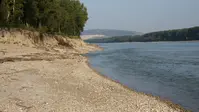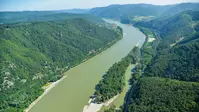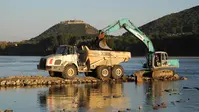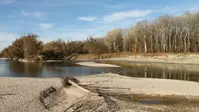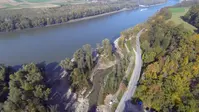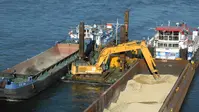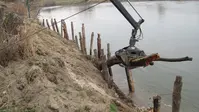Depending on river and objectives, various measures are implemented in the field of ecological hydraulic engineering. Amongst others, these include:
Riverbank restoration
Bank reinforcements made of armourstone stabilise the shoreline, but prevent interaction between the river and the surrounding land. The ecologically valuable transition between water and land is broken. Moreover, the erosive force of the water can no longer dig the sediment off the bank, but has an increased effect on the river bed and digs it deeper. By removing the hard bank protection, the Danube, Morava and Thaya could be freed from their tight corset in individual areas. Erosion and sedimentation processes have created natural steep and flat banks, which are constantly changing dynamically. Freshly formed banks are particularly important for sand martins and kingfishers. The shallow gravel banks, on the other hand, are often used as breeding areas by sandpipers or little ringed plovers. The removal of stone barriers is of course only possible where there is no danger to human facilities in the surrounding area. Restoring banks gives the river more space, which is referred to as widening the cross-section. In this way, the measures also contribute to flood protection.
Sidearm reconnection
Often they were hardly visible in the landscape: the original tributaries which were cut off from the main stream. Progressive silting up caused the flow to become less and less frequent, and the remnants of the watercourse became veritable fish traps. Since the first tentative attempts to reconnect tributaries, we have learned one thing above all: to design a generous and deeply connected inflow funnel.
Only where a watercourse has year-round flow and a continuous deep channel, they are preserved in the long term. The tributaries provide valuable habitat for flow-loving fish species and are a key habitat for juvenile fish. The tributaries are also subject to ongoing dynamic changes in the banks and riverbed, which are particularly visible after flood events. Watercourse cross-links also contribute to flood protection, as the tributary can absorb part of the water. If possible, islands created by watercourse networks are not developed, and largely undisturbed floodplain wilderness areas are created.
Optimisation of groynes
Raising the low-water level in the mainstream of the Danube is a common goal of ecology and navigation. This is achieved, among other things, by groynes for low-water regulation. Groynes are made of armourstone and are poured in the form of elongated stone bars at right angles to the direction of flow of the river. The water levels are raised and during low water the water is concentrated in the navigation channel.
As part of the Witzelsdorf pilot project, a groyne field was redesigned for the first time in such a way that the regulatory structures originally built for navigation can also achieve ecological benefits. The groynes were lowered in height, significantly reduced in number and inclined more in the direction of the Danube's flow. Optimising the structures to achieve the desired effects proved to be extremely difficult. The project area is constantly monitored and adapted if necessary.
Gravel structures
For the preservation of the Danube waterway, dredging of the riverbed in ford areas is carried out on an ongoing basis. Gravel from the fairway is used to create gravel banks and islands near the banks. The newly created gravel structures and islands create areas of water that are protected from the waves of ships. They serve as spawning and refuge areas for Danube fish fauna and as habitats for gravel-breeding bird species. On gravel structures that are not flooded by high water for a longer period of time, pioneer vegetation with herbaceous plants or various willow species can also establish themselves. The creation of "backwaters" has a similar effect. In this measure, gravel banks on the river bank are decoupled from the bank by dredging a deep channel.
Free migration paths
Estuaries of tributaries that are formed as steep steps are barriers for the migration routes of organisms. However, some fish species of the Danube and Morava need the tributaries as spawning grounds and can then no longer reach them. By redesigning and widening the estuary area and dissolving the steep steps, passability for fish and other organisms can be achieved again.
Bedload management
In the free-flowing stretches of the Austrian Danube, the river is digging deeper and deeper into its riverbed. Within 50 years, the Danube east of Vienna had dug itself in by about one metre. As the riverbed sinks, so do the surface and groundwater levels, threatening the sensitive ecosystem of the Danube floodplains. The main reason for the deepening of the riverbed is the interruption of the river's natural gravel transport by the dams of the power plants. The canalisation of the river into a single river bed also plays a role because it increases erosion forces.
viadonau implements measures to reduce these deepening tendencies. The gravel dredged during maintenance of the danube's fairway is not removed from the river, but is instead diverted upstream and dumped again. Gravel is also extracted in bedload catchments for bedload management. Bank reconstructions, watercourse linkages as well as the optimisation of low-water regulation contribute to the relief of the riverbed and reduce the deepening rates.
Ecological bank stabilisation
Hard structures made of armourstone do not always have to be used to reinforce riverbanks. Especially on the rivers Morava and Thaya, banks are protected by ecological, near-natural bank stabilisation. Here, tree trunks that have fallen into the river and can lead to clogging are removed and reinstalled in the affected bank areas to secure them.
